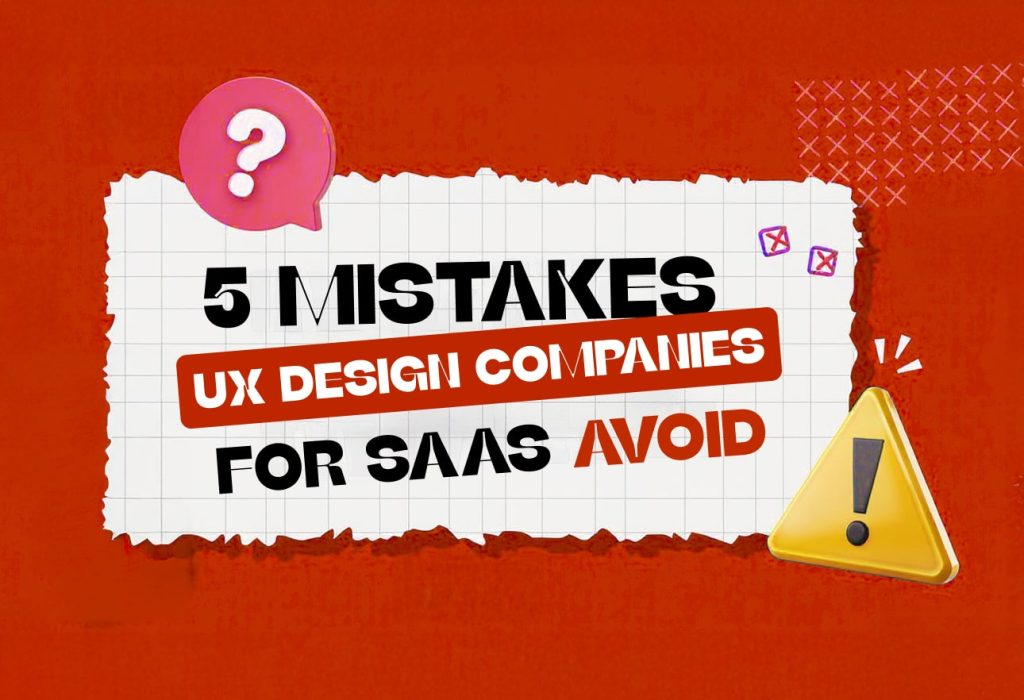What SaaS Founders Need to Know to Transform their SaaS Business Performance?
Developing a successful SaaS product requires balancing many factors. You need powerful features, a stable platform, and a smart marketing strategy. But what ties it all together? An user experience that is well designed can turn casual users into loyal advocates, reduce churn, and drive revenue. A poor UX, however, will send them straight to your competitors.
What Expert Designers Know about Building Better SaaS products
SaaS companies often face the same UX challenges. In order to create a great product, you need to avoid these challenges. There is no doubt that the best UX design companies for SaaS products and freelance UX designers understand this. They know that a seamless experience is not an accident. It is the result of deliberate, user-centered design. This guide will walk you through 5 critical UX mistakes that the best UX design companies for SaaS products consistently avoid. By understanding these challenges, you can improve your product, delight your users, and build a stronger business.
1. Ignoring In-Depth User Research
A common mistake many software-as-a-service (SaaS) founders make is designing their products based on assumptions rather than real evidence. Since founders are often very passionate about their ideas, they can overlook major issues. By assuming that they know what users want and need, they create products that are too confusing for users or don’t solve problems for them. A well-designed SaaS product is based on the understanding of its users, so the best UX design firms make every decision based on research.
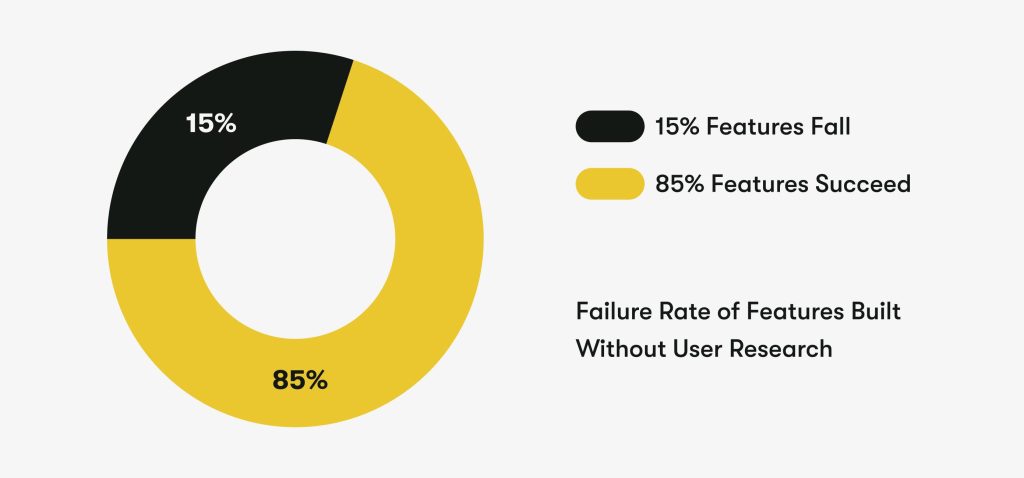
What Top Designers Do Instead
Providing exceptional user experiences requires an extensive discovery phase. It goes beyond a simple survey, it digs deep into the lives of users.
- Conducting User Interviews: In user interviews, they uncover the “why” behind the actions of actual and potential users by asking open-ended questions. For instance, instead of the question, “Do you want a dashboard?”, the question would be, “Tell me about how you start your workday and what information you need first.”
- Creating User Personas and Journey Maps: Research is used to develop user personas that include demographics, motivations, frustrations, and technical skills. Identifying each touchpoint with the product and the emotions associated with it, they map out the user’s journey.
- Analyzing Competitors: They look at what their competitors are doing, but they also analyze why it works or doesn’t work. Heuristic evaluations of a competitor’s usability may allow them to create a better product by identifying their strengths and weaknesses.
Actionable Tip for Your SaaS
Before you even write one line of code, you should reach out to a minimum of five to ten users to discuss and validate the idea. Ask them about their current pain points. Even simple video calls can provide valuable insight that can save months of development time. Their answers will guide your design far more effectively than your internal assumptions.
2. Overcomplicating the Onboarding Process
Onboarding is a product’s first impression, and a complex, lengthy, or confusing onboarding process leads to high user churn rates. Users expect immediate value when they sign up. If they have to navigate a 20 step tutorial or read a lengthy guide to understand the basics of the system, they will lose interest & leave. Great UX design focuses on getting users to their “aha!” moment as quickly and smoothly as possible. This is the moment they first experience the core value of your product.
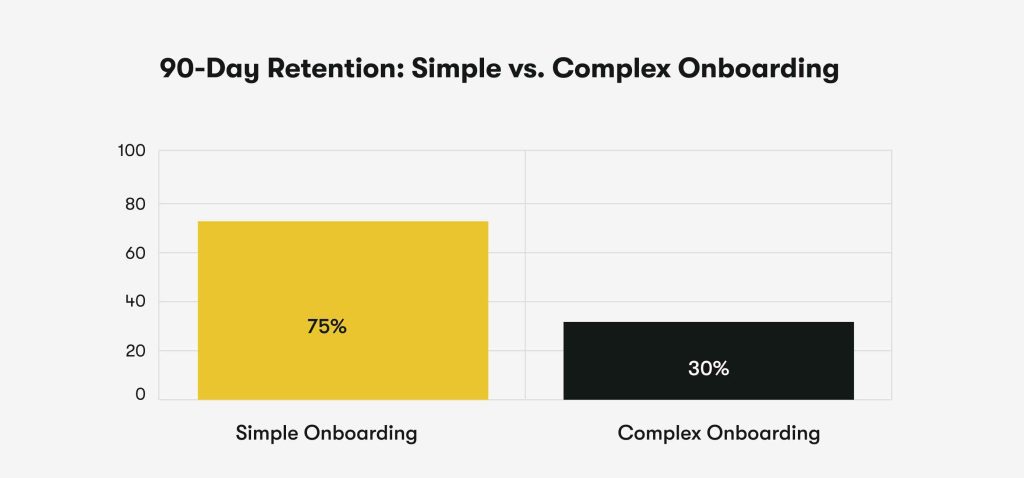
How to Create a Seamless Onboarding Flow
Top UX designers treat onboarding as an integral part of the product, not an afterthought. Their goal is progressive disclosure and learning by doing.
- Prioritizing the “Aha!” Moment: Onboarding processes are designed to guide users to the key action that makes users realize and feel the product’s value with the least amount of friction. Creating and assigning your first task in Asana is the same as sending your first message in Slack
- Using Contextual Cues: Instead of being presented with a detailed tour upfront, users are guided by tooltips and hotspots as their exploration of the interface continues. For example, when a user first visits the reporting section, a tooltip explains how to create a report.
- Implementing Empty States: Having an empty dashboard can be intimidating. The best designers use these “empty states” as an opportunity to guide users. Instead of showing a blank screen, they provide a clear CTA, a short video tutorial, or sample data to illustrate what the screen will look like. It transforms a potential point of confusion into an opportunity for instruction.
Actionable Tip for Your SaaS
In your current onboarding process, are new users able to complete one meaningful task in less than three minutes? If not, it’s too complex. Identify the single most important action to make a user successful. Make the initial experience as simple and straightforward as possible.
3. Designing Inconsistent User Interfaces (UI)
What if every page of a book had a different font, size, or style? It’d be pretty confusing, right? Well, the same idea applies to the user interface of a SaaS product design. It can be frustrating for users to learn the interface again each time the buttons, icons, colors, or layout change without any reason. Which increases cognitive load, making the product feel clunky, unprofessional, and difficult to use. The best UX design companies for saas products understand that sticking to a consistent design is key for usability. It helps users feel comfortable and confident as they navigate the application.
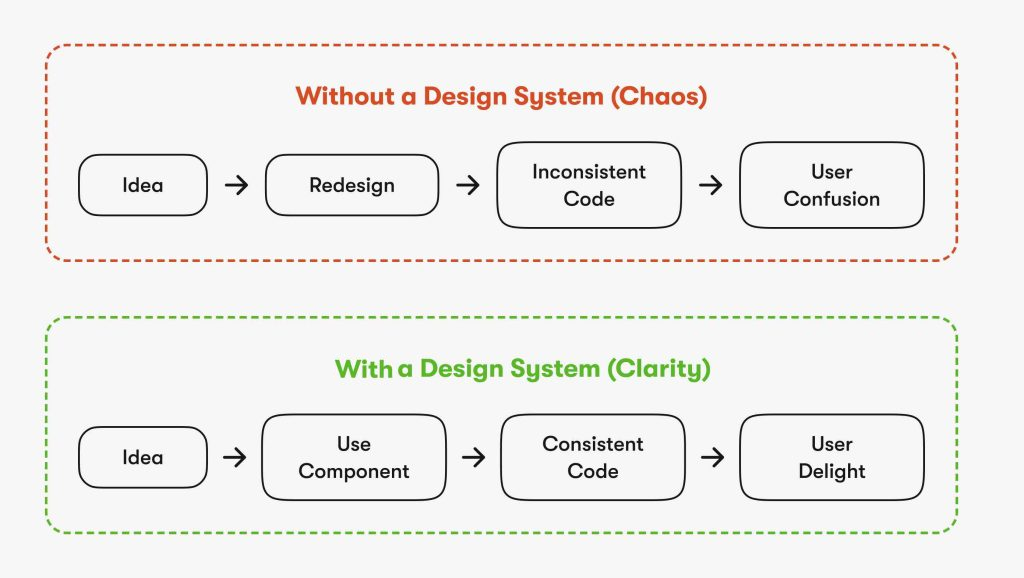
The Power of a Design System
One solid way to maintain consistency across your SaaS product is by creating and using a design system. It’s a comprehensive library of reusable UI components (buttons, forms, modals), style guidelines (colors, typography, spacing), and principles. Every time a new version is released, it evolves along with the product.
Benefits of a Design System:
- Consistency: A design system ensures that all parts of your application feel like it belongs to the same product.
- Efficiency: By using pre-made, pre-approved components, designers and developers can build new features more quickly reducing both redundant tasks and time spent on development.
- Scalability: A design system keeps the product organized, helping your team work together effectively and avoiding a confusing mix of different UI elements.
Actionable Tip for Your SaaS
You don’t need a massive design system right off the bat. Just start with the basics. Create a simple UI style guide that includes your primary colors, font, button styles, and commonly used icons. Make sure your entire team can easily access this guide. When working on new features, refer back to this guide to keep everything consistent. These small step can really help create a more cohesive user interface design.
4. Hiding or Complicating Key Actions
Users typically have specific tasks in mind when they use your SaaS product such as generating a report, sending an invoice, or analyzing some data. They will feel frustrated if the core functionality of your SaaS product is hidden under multiple menus or represented by ambiguous icons. A visual hierarchy and intuitive information architecture are necessary to create an experience that is easy to navigate for the user.
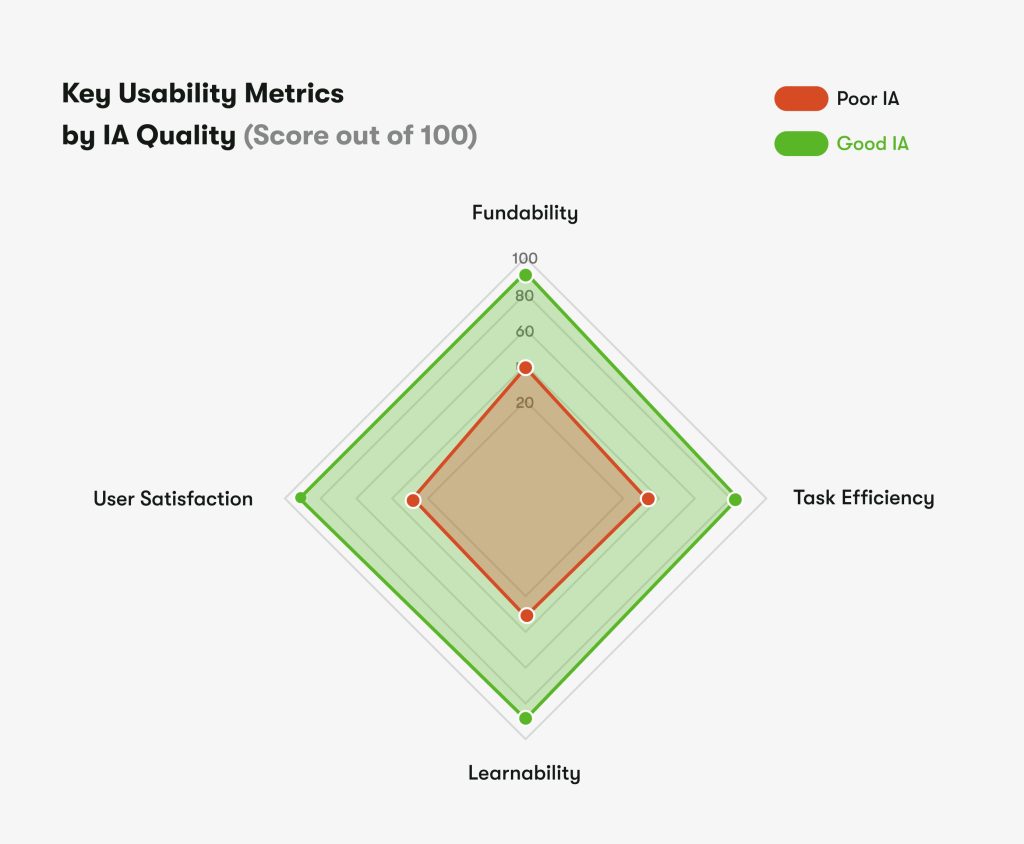
Creating an Intuitive Information Architecture
Information architecture (IA) is about how we organize and label content so that it facilitates usability and findability.
- Prioritizing Actions: It is important to identify the tasks that users perform most often. For example, in accounting software, the “Create Invoice” button should be front and center, rather than hidden away in a dropdown labeled “Miscellaneous.”
- Using Clear Language: Rather than using internal jargon or clever, but unclear labels, they use plain language. It is important to make the interface speak the user’s language. “Save” is better than “Finalize Configuration.” “Settings” is more intuitive than “Preferences & Modulations.”
- Logical Grouping: Organizing related items into groups. All account-related functions (Profile, Billing, Security) should be found under an “Account” or user profile menu. All analytics features should be in the “Reports” or “Analytics” section. As a result, users are able to build a mental model of the application, making it easier to use.
Actionable Tip for Your SaaS
Take the 3 most common tasks your users perform and see how many clicks it takes to complete them. Ask someone who isn’t familiar with your product to try the same tasks while you observe. Where do they pause or seem confused? This simple check can help you identify areas where your UX could use a little polishing.
5. Neglecting Mobile and Responsive Design
The way we work keeps changing these days. More and more people are entering SaaS applications from smartphones and tablets. Developing a SaaS product that can only be used from a desktop is no longer sufficient. Mobile users accessing your platform face a shrinking desktop interface, which requires constant pinching and zooming. Best UX companies for SaaS products prioritize mobile first design. Its no longer an option for a modern SaaS product, but a must have requirement to be responsive.
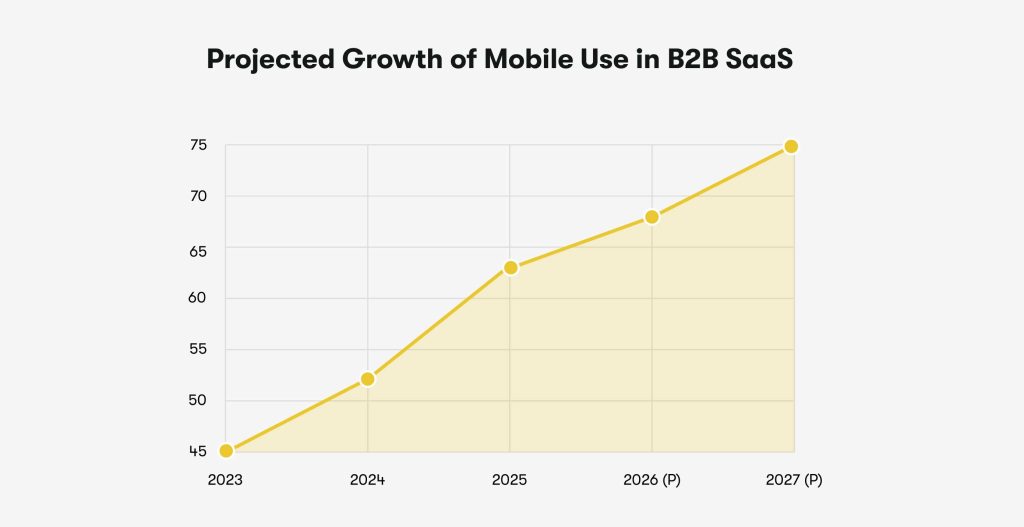
Why Responsive Design is Non-Negotiable
A responsive design automatically adjusts to fit whatever screen size the user is on, making every interaction smoother.
- Meeting User Expectations: Users now expect to check in on their work wherever they are. For instance, sales managers might want to pull reports on their tablets before meetings, while project managers may need to update the status of tasks on their smartphones. If you don’t offer a great mobile experience, it can cost you opportunities.
- Designing with Constraints: Taking a mobile-first approach forces designers to make important choices. With less space to work with, it is necessary to focus on the content and actions that matter most. This streamlined approach benefits everyone, even desktop users, as it results in a clearer, more focused experience.
- Future-Proofing Your Product: Number of internet enabled devices is only going to continue rising. By ensuring your product is flexible and responsive, you’ll be prepared for future devices without needing a complete redesign.
Actionable Tip for Your SaaS
You do not have to create a separate mobile application first. Start by ensuring that your web application is fully responsive. Using as many different screen sizes and models as possible, test your product on various screens. Can users log in, navigate, and complete at least one essential action on their phones? Prioritize the ability for users to take care of important tasks on the go. They may not need to adjust complex settings on their phones, but they should certainly be able to view their dashboard or respond to a notification easily.
Solution: Choose Neurotive
Design consistency and quality are crucial for this crowded SaaS market. Neurotive is an innovative B2B SaaS design agency that could be the right design partner for your SaaS startup. They offer a flexible monthly UX design subscription specifically for SaaS products, providing high-impact design services that will help scale your product quickly, save you time, and keep you competitive without hassle.
Subscribe to UX Design monthly to boost SaaS growth
Neurotive‘s monthly SaaS design service gives you access to the expertise of a team of professionals with years of experience in B2B SaaS product design. You will get reliable support for product updates, user interface updates, and new features with this subscription. Using Neurotive’s monthly service model, you won’t have to hire freelancers repeatedly or wait for agencies to deliver.
- Consistent, High-Quality UX: With our design subscription, you never have to worry about missed deadlines due to unmet requests and revisions.
- SaaS Design Services at Scale: Neurotive offers innovative and detail-oriented services, driving results for both startups and established SaaS companies.
- A Trusted Design Partner for SaaS Startups: Our goal is to build long term partnerships that create measurable improvements for your product.
Many SaaS businesses, through our customized SaaS design services, have managed to speed up their processes, cut costs, and enhance user retention. As a SaaS startups’ true partner, Neurotive provides monthly subscription-based UX design services.

